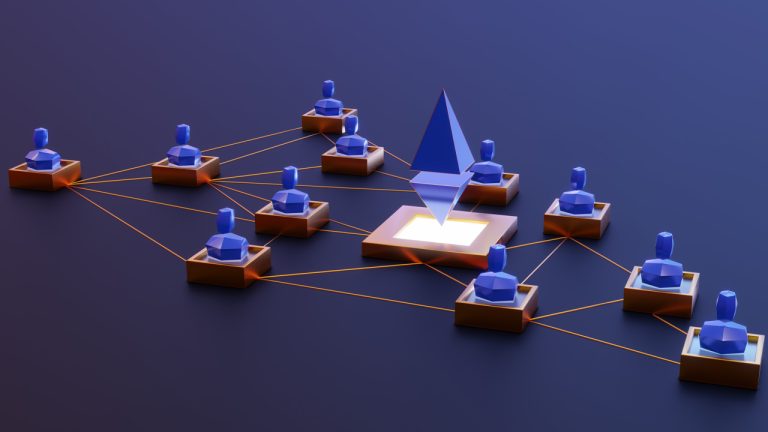 According to Coingecko’s 2024 Q3 Crypto Industry Report, the global cryptocurrency market closed flat, ending the quarter with a $2.33 trillion market cap. However, the period saw considerable volatility driven by geopolitical and economic events across major markets. Q3’s Crypto Winners and Losers: Coingecko’s Report Breaks It Down Coingecko’s latest report highlights that the crypto […]
According to Coingecko’s 2024 Q3 Crypto Industry Report, the global cryptocurrency market closed flat, ending the quarter with a $2.33 trillion market cap. However, the period saw considerable volatility driven by geopolitical and economic events across major markets. Q3’s Crypto Winners and Losers: Coingecko’s Report Breaks It Down Coingecko’s latest report highlights that the crypto […]

Experts say BTC and ETH derivatives will be instrumental in integrating crypto to TradFi and sending each to new all-time highs.
Bedroom crypto traders and analysts have frequently expressed concern at Bitcoin’s (BTC) inability to overcome is all-time high, but professionals from the Chicago Mercantile Exchange (CME), TradingView and TJM Institutional Services believe that the launch of a spot Bitcoin ETF will play a key role in sending BTC’s price to the highs traders dream of.
While speaking at Consensus on the role crypto derivatives will play in tomorrow’s market, TradingView general manager Pierce Crosby explained that derivatives have always been a integral part of the crypto traders’ experience, but trading at the centralized exchanges available from 2015 to 2022 meant many spot and margin traders had their “face ripped off” by high fees and slippage.
Crosby said,

Starknet has laid out its roadmap to begin decentralizing core components of its Ethereum L2 scaling network to defend against censorship and improve robustness.
Ethereum layer-2 scaling network Starknet has outlined plans to improve the decentralization of three core components of its zero-knowledge (ZK) proof rollup solution.
Speaking exclusively to Cointelegraph, Starknet product manager and blockchain researcher Ilia Volokh outlined the firm’s intent to address certain centralized elements of its protocol aimed at defending against censorship and making its system more robust.
Starknet operates as a validity rollup using ZK-proof technology to bundle transactions, with cryptographic proofs submitted to Ethereum to achieve security and finality for layer-2 transactions.
According to Volokh, Starknet’s protocol remains dependent on StarkWare for creating L2 blocks, computing proofs and initiating layer-1 state updates to the Ethereum blockchain.
“In this sense, the operation of the network is centralized. This is not necessarily a bad thing because although Starkware operates the network, it cannot steal money and can’t do any invalid state transitions because they require executing the verifier on Ethereum,” Volokh explained.
While Starkware remains a “centralized gateway” to enter Starknet, Volokh added that the protocol is “100% honest” and cannot falsify transactions or information, as Ethereum’s layer-1 blockchain acts as a filter.
The only tangible way in which Starknet can “misbehave” is either by being idle in not relaying proofs to Ethereum or by specifically censoring certain parties from including transactions or proofs.
“For example, if the sequencer decides to exclude a transaction from a particular entity, they’re free to do so. As long as the other things that they are trying to promote are valid.”
For Starknet, the latter consideration is part of the main reason to decentralize parts of its protocol in an effort to combat two main causes of censorship in consensus-based systems.
Intentional censorship is one consideration, while “non-robust” systems that have a single point of failure present another threat to decentralization, given that all network participants would be “censored” if this central point caused a network or system outage.
“We want to solve both of these problems, and we think the obvious solution to both of them at the same time is to have as many people operating Starknet as possible.”
Decentralizing these different components of Starknet’s system entails varying degrees of difficulty. This includes decentralizing block production through its consensus protocol, decentralizing the proving layer, which is in charge of computing proofs for blocks and decentralizing the process of L1 state updates.
“I want to emphasize that it’s crucial to decentralize each of them because as long as even one of them is centralized, you haven’t achieved much,” Volokh added before unpacking the relevant challenges of each component.
Decentralizing block production has been fairly straightforward given that all blockchains rely on a consensus protocol and sybil-resistance mechanism. Meanwhile, decentralizing Starknet’s prover has required a more novel approach.
“As far as I know, we’re the first rollup that has come out with a fairly complete and concrete solution,” Volokh said. He also went on to unpack how competing ZK-rollups all essentially aggregate transactions into proofs and post them on Ethereum, which by extension transfers its own decentralization to rollup solutions.
However, these systems all rely on respective central entities to create and prove blocks, which means these layer 2s are “equally centralized.” Whether end users are concerned about the philosophical implications of the centralized components of L2s is another conversation altogether for Volokh:
“The people who appreciate decentralization do so because they understand that it gives more security, and we share those values more than we think people will like them for commercial reasons.”
Volokh added that Starknet is still in the process of outlining the process of testing and implementing these decentralized mechanics in its network. This is likely to be carried out through a series of interconnected testnets to test the simultaneous functionality of the different components.
Magazine: Here’s how Ethereum’s ZK-rollups can become interoperable

VitaDAO community agreed to fund an early-stage cancer research through the launch of a biotech company named Matrix Biosciences.
VitaDAO, a decentralized collective dedicated to early-stage longevity research, funded the launch of a biotech company, Matrix Biosciences, dedicated to the treatment of cancer and aging diseases.
The initial discussions around the use of high molecular weight hyaluronic acid (HMW-HA) for anti-cancer and pro-longevity effects started off in November 2022 and gained majority consensus in March 2023. The proposal snapshot reveals that 35 members cast their votes using VITA tokens.

Out of the lot, 30 members supported the cause, 4 members abstained from voting, and 1 voted against the proposal. As an active contributor in decentralized science (DeSci), VitaDAO made an initial investment of $300,000 and plans to carry out further funding through tokenization of intellectual property (IP) in early 2024.
The HWA-HA compound is derived from the tissues of naked mole rats, a type of rodent that possess stronger cancer resistance which is responsible for their higher lifespan.
Speaking to Cointelegraph, a VitaDAO spokesperson revealed that the funds have been provided to Matrix Bio by converting USD Coin (USDC) stablecoins from the community treasury to the US dollar and wired to their bank account.
Related: 9 promising blockchain use cases in healthcare industry
Once the first batch of experiments is complete, Matrix Bio will have the option to raise additional funding by issuing IP Tokens (IPTs) in return for sharing governance rights in the ongoing development of the IP. The next round of fundraising will commence after the budget for the next phase of development is established, expected in Q1 2024.
VitaDAO believes modulating HMW-HA appears to be a viable therapeutic candidate in supporting the treatment of a complex disease like cancer. The DAO told Cointelegraph:
“Like most early-stage research, it is too early to know what the outcome of the research will provide. VitaDAO believes there is a high likelihood that the research will be translatable to the clinic.”
While the DAO’s commitment to funding this particular cancer research will depend on the results obtained from the various experiments, VitaDAO’s community treasury has in the past funded up to $1 million of a research project’s needs before enlisting the support of professional investors and pharma stakeholders.
Magazine: Beyond crypto: Zero-knowledge proofs show potential from voting to finance

Buterin has advocated preserving Ethereum consensus minimalism and not overloading validators with other things.
Ethereum co-founder Vitalik Buterin has published a lengthy blog post warning of the dangers of “stretching” Ethereum's consensus past its core functions of validating blocks and securing the network.
Ethereum consensus is the process whereby blocks are validated by the proof-of-stake mechanism implemented in September 2022 with “the Merge.”
In a May 21 blog post titled “Don’t overload Ethereum’s consensus,” Buterin warned that using Ethereum’s network consensus for other things could bring “high systemic risks to the ecosystem and should be discouraged and resisted.”
The Ethereum co-founder was essentially promoting the preservation of the blockchain’s minimalism.
Don't overload Ethereum's consensus:https://t.co/07tzyCrZcJ
— vitalik.eth (@VitalikButerin) May 21, 2023
Buterin noted that over the years, a number of proposals or ideas had floated around that suggested using the Ethereum social consensus for other purposes, such as price and data oracles, re-staking initiatives and using layer-1 soft forks to recover layer-2 projects should they have issues.
“There is a natural urge to try to extend the blockchain’s core with more and more functionality because the blockchain’s core has the largest economic weight and the largest community watching it, but each such extension makes the core itself more fragile.”
Buterin said that a certain subset of these techniques could bring “high systemic risks” to the ecosystem, such as bugs or an intentional 51% attack.
Some high-risk examples include creating ETH/USD price oracles in which ETH (ETH) holders or validators can be bribed to vote on, which may result in a “fork out the bad participants' money” if there is disagreement.
However, he acknowledged a need for better oracles, proposing a case-by-case approach because various problems are “inherently so different” from each other.
Overall, Buterin said that any expansion of the “duties” of Ethereum's consensus increases the costs, complexities, and risks of running a validator.
Related: Buterin weighs in on zk-EVMs’ impact on decentralization and security
Application-layer projects “taking actions that risk increasing the ‘scope’ of blockchain consensus to anything other than verifying the core Ethereum protocol rules,” should be treated with caution, he said, summarizing:
“We should instead preserve the chain’s minimalism, support uses of re-staking that do not look like slippery slopes to extending the role of Ethereum consensus, and help developers find alternate strategies to achieve their security goals.”
The Ethereum consensus mechanism switched from proof-of-work to proof-of-stake in September last year. Additionally, staked Ethereum has only just been released for withdrawal with the Shapella upgrade on April 12. This explains the increased scrutiny of validator roles and security risks on the world’s largest smart contract network.
Magazine: ‘Account abstraction’ supercharges Ethereum wallets: Dummies guide
 Ethereum had issues processing transactions on May 11, 2023, at around 4:13 p.m. Eastern Time on Thursday, and transaction finality issues lasted for roughly 25 minutes. Currently, developers do not know what caused the issue and the blockchain is now running normally. Ethereum Network Experiences Temporary Transaction Processing Issue The Ethereum blockchain was unable to […]
Ethereum had issues processing transactions on May 11, 2023, at around 4:13 p.m. Eastern Time on Thursday, and transaction finality issues lasted for roughly 25 minutes. Currently, developers do not know what caused the issue and the blockchain is now running normally. Ethereum Network Experiences Temporary Transaction Processing Issue The Ethereum blockchain was unable to […]
Despite negative sentiment toward crypto adoption in the United States, Consensus 2023 attracted thousands of attendees to discuss the potential of blockchain technology and cryptocurrency.
Consensus, the annual crypto and blockchain conference, attracted over 15,000 attendees, 220 sponsors and 410 speakers to its 2023 edition in Austin, Texas, despite recent regulatory struggles around cryptocurrency adoption in the United States.
The turnout at Consensus 2023 demonstrated that U.S.-based companies and international organizations are still very much interested in implementing Web3 technology into their business models.
Caitlin Long, founder and CEO of Custodia Bank — a Wyoming-based digital asset bank — told Cointelegraph that the conference attracted serious ecosystem participants, saying, “We’ve seen during crypto winters before where Consensus gets overrun with high time preference people and companies (for example, multiple Lambo’s parked out front of the New York Hilton in 2018), and in bust years the low-time preference people and companies just keep building. This year was the latter.”
ADIOS AUSTIN! This was my fave #Consensus conf since 2017—by my guess it had the highest % in attendance of fellow “low-time preference peeps on principled missions” since that year. Huge thanks to everyone who showed your support—it was like a great big warm hug! Safe home! pic.twitter.com/NOPmU03VAV
— Caitlin Long ⚡️ (@CaitlinLong_) April 29, 2023
Several large organizations were present at Consensus 2023, with Mastercard, Google, Robinhood and Coinbase, among others, gathering to discuss their Web3 strategies.
James Tromans, head of Web3 at Google Cloud, told Cointelegraph about some blockchain-based initiatives the company has recently launched.
“At the end of last year, Google Cloud announced Blockchain Node Engine, which allows users and developers to run an Ethereum node without having to manage or support it themselves,” he said.
Recent: Will compromise on anonymous crypto appease US regulators, spur adoption?
At Consensus, the firm announced that it had expanded support for the Blockchain Node Engine to Polygon proof-of-stake, in addition to Ethereum.
Tromans added that Google Cloud knows what Polygon has been doing in the zero-knowledge (ZK) space, noting that Polygon ZK Ethereum virtual machines (zkEVM) and Polygon supernets will benefit from the provision of Google Cloud’s infrastructure and developer tools.
Moreover, Tromans pointed out that Google Cloud’s startup program will help onboard companies interested in building on Web3 using existing Google Cloud products. “Polygon is an important part of this initiative, as they have provided a $3 million contribution from their venture fund to get this off the ground with us,” he said.
Global financial services giant Mastercard announced its “Mastercard Crypto Credential” solution during Consensus. Raj Dhamodharan, head of crypto and blockchain at Mastercard, stated during a fireside discussion at Consensus that he is “excited about the underlying potential of blockchain technology” due to its ability to store and move value seamlessly.
However, Dhamodharan explained that “this potential is not fully realized today,” so Mastercard has started working on several products like Mastercard Crypto Credential.
“I believe that once you have the right building blocks necessary for safety and simplicity, you can have more businesses building and relying on the basic utility of storing and moving value,” Dhamodharan said on stage.
While there were 10 dedicated stages for 285 panels during Consensus, many side events allowed important conversations to continue outside of the conference.
For example, zero-knowledge proofs (ZK-proofs) were widely discussed at Consensus, but in-depth conversations around ZK-proofs took place at the “ZK360” event hosted by Mina Protocol. Evan Shapiro, CEO of the Mina Foundation and co-founder of the Mina Protocol, told Cointelegraph that the goal of ZK360 was for attendees to learn about the latest advancements in ZK-proofs and how these can be applied in the real world. “Web3 needs both privacy and verified computation. ZK-proofs provide both of those at a time when applications are needing these features to be more effective, decentralized and scalable,” he said.

Other layer-1 blockchain networks like Ripple and Algorand hosted side events, allowing Consensus attendees to better understand specific blockchain offerings while networking with community members. These events also presented an opportunity for non-Consensus attendees to learn about important topics within the Web3 sector.
While the turnout during Consensus 2023 was notable, some industry experts highlighted that the conference lacked an international presence.
Yat Siu, chairman of Animoca Brands — a venture capital company focused on blockchain-based games — told Cointelegraph that regions in Asia like Japan and Hong Kong are offering a progressive and welcoming regulatory environment for crypto adoption. He noted that most people he spoke with at Consensus seemed surprised or even skeptical at this. He said:
“I think that a larger presence of overseas participants would have helped allow Consensus participants to better understand the scope of excitement and opportunity that exists outside of the United States. I would love to see a stronger international presence at Consensus next year.”
Despite this, Siu said that Consensus 2023 was a well-attended, high-energy conference overall. “I was surprised at the level of deal-making activity that was taking place, even if the narrative was that the U.S. was negative on crypto,” he said.
Magazine: How to control the AIs and incentivize the humans with crypto
Echoing Siu was Keith Grossman, president of enterprise at MoonPay. He told Cointelegraph that he was impressed to see so many executives from some of the largest companies in attendance at Consensus. “Deals were being discussed, and I believe we will look back at Consensus 2023 recognizing it represented a maturation in the industry as it relates to how Web3 technologies can be deployed in a meaningful manner for businesses and their customers.”

Robinhood Markets announced the launch of its new ‘Robinhood Connect’ service and numerous updates to its app.
The launch of ‘Robinhood Connect,’ a fiat-to-crypto on-ramp featuring support for decentralized applications (DApps) and self-custody wallets, was announced at Consensus 2023 on April 27.
Introducing our latest investment in crypto, Robinhood Connect: https://t.co/SmENSYufBA
— Robinhood (@RobinhoodApp) April 27, 2023
A low-cost, on-ramp for customers, and a seamless integration for developers. Learn more: https://t.co/rnBnR0LYww pic.twitter.com/6uSIAJkudO
Positioned as a competitor to similar services such as Coinbase Pay and MoonPay, Robinhood Connect essentially allows users purchase and sell cryptocurrency directly to and from their self-custody wallet or natively in DApps using a credit or debit card.
Robinhood Connect features integration with Web3 projects as developers can embed the service directly into applications. This allows customers to access their Robinhood credentials natively in DApps without having to open the Robinhood website or app separately to log in and conduct transactions.
Currently, the service is only available in the MyDoge, Giddy, and Slingshot ecosystems but upcoming support for Exodus and Phantom has been announced.
Johann Kerbrat, general manager of Robinhood Crypto, explained in a company blog post that the service was developed in hopes of bringing more people into the cryptocurrency space:
“Crypto and Web3 have the potential to change the future of the financial system for the better, but we recognize there are still significant hurdles preventing broader adoption.”
The market for fiat-to-crypto services such as Robinhood Connect isn't exactly crowded, but Robinhood represents one of the only companies associated with traditional finance to enter the space.
As of January 2023, Robinhood claims to have 23 million total user accounts and $74.7 billion in assets under custody. This is significantly lower than Coinbase's claimed 110 million verified users, but the asset count remains similar (Coinbase says it holds $80 billion in on-platform assets). For comparison, rival companies MoonPay and Webull have an estimated five and 13 million users, respectively.
Along with the launch of Robinhood Connect, the company also announced several changes to the Robinhood app, such as the ability to conduct advanced orders via stop orders and stop limit orders.
Related: Robinhood board gives nod to buy Sam Bankman-Fried’s $578M stake
The new service and app upgrades come just a couple of months after the launch of Robinhood’s own branded self-custody wallet on the iOS App Store, which currently has a 3.9-star rating and ranks #144 in downloads for the finance category.
 While bitcoin’s effect on the environment has been discussed at length over the last two years, the latest trend of artificial intelligence (AI) software is now being criticized for its carbon footprint. According to several headlines and academic papers this year, AI consumes significant electricity and leverages copious amounts of water to cool data centers. […]
While bitcoin’s effect on the environment has been discussed at length over the last two years, the latest trend of artificial intelligence (AI) software is now being criticized for its carbon footprint. According to several headlines and academic papers this year, AI consumes significant electricity and leverages copious amounts of water to cool data centers. […]
Vitalik Buterin has weighed the impacts of the addition of zk-EVMs at the protocol level, saying it could speed up the verification process on the base layer.
Ethereum co-founder Vitalik Buterin wants to see zero-knowledge Ethereum Virtual Machines (zk-EVMs) built on Ethereum’s first layer to speed up the verification process on the base blockchain.
Buterin explained in a March 31 post that it’s possible to integrate a zk-EVM on the base layer without compromising on decentralization and security. The technology enables Ethereum Virtual Machines to execute smart contracts on the blockchain with ZK proofs.
How will Ethereum's multi-client philosophy interact with ZK-EVMs?https://t.co/MPpTPNhldR
— vitalik.eth (@VitalikButerin) March 31, 2023
Ethereum was developed with a “multi-client philosophy” to ensure decentralization at the protocol level, Buterin explained. By integrating zk-EVMs at the Ethereum layer 1, it would be the third type of client.
“Once that happens, zk-EVMs de-facto become a third type of Ethereum client, just as important to the network's security as execution clients and consensus clients are today.”
The other two clients are the “consensus” and “execution” clients. The consensus client implements proof-of-stake to ensure nodes in the network reach agreement. While the execution listens to new transactions broadcasted in the network, executes them in standard EVM and holds a copy of the latest state of the blockchain.
In championing the idea of zk-EVM verification at the Ethereum base layer, Buterin firstly considered the advantages and drawbacks of treating the layer 1 as a “clearinghouse” by pushing almost all activity to layer 2’s.
He said many layer 1-based apps would become “economically nonviable” and that small funds — worth a few hundred dollars or less — may get “stuck” in the event that gas fees grow too large.
Buterin explained that zk-EVMs would need to be “open” in that different clients each have different zk-EVM implementations and each client waits for a proof that is compatible with its own implementation before accepting a block as valid.
He prefers this approach because it wouldn’t abandon the “multi-client” paradigm, and an open zk-EVM infrastructure would also ensure that new clients could be developed, which would further decentralize Ethereum at the base layer.
Related: ConsenSys zkEVM set for public testnet to deliver secure settlements on Ethereum
Buterin said zkEVMs may be the solution to “The Verge,” a part of the Ethereum roadmap which aims to make verification at the base layer easier.
Updated roadmap diagram! pic.twitter.com/MT9BKgYcJH
— vitalik.eth (@VitalikButerin) November 4, 2022
Buterin acknowledged that the zk-EVM infrastructure may cause data inefficiency and latency issues, however he said those challenges wouldn’t be “too hard” to overcome.
If the zk-EVM ecosystem is implemented, it would make running a full node on Ethereum even easier, Buterin explained:
“Ethereum blocks would be smaller than today, anyone could run a fully verifying node on their laptop or even their phone or inside a browser extension, and this would all happen while preserving the benefits of Ethereum's multi-client philosophy.”
Ethereum layer-2 scaling platform Polygon has made considerable progress with its zk-EVM, having recently open-sourced its zkEVM to the Polygon mainnet on March 27, promising reduced transaction costs and increased throughput of smart contract deployments.
StarkWare, ConsenSys, Scroll, zkSync and Immutable are also deploying similar zkEVM scaling solutions.